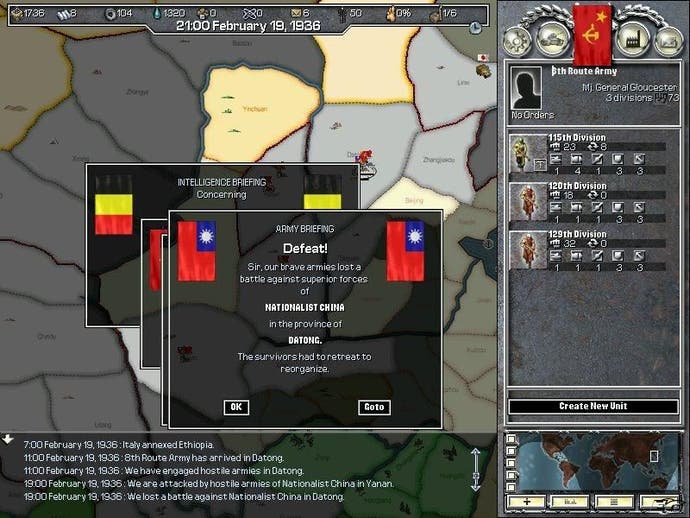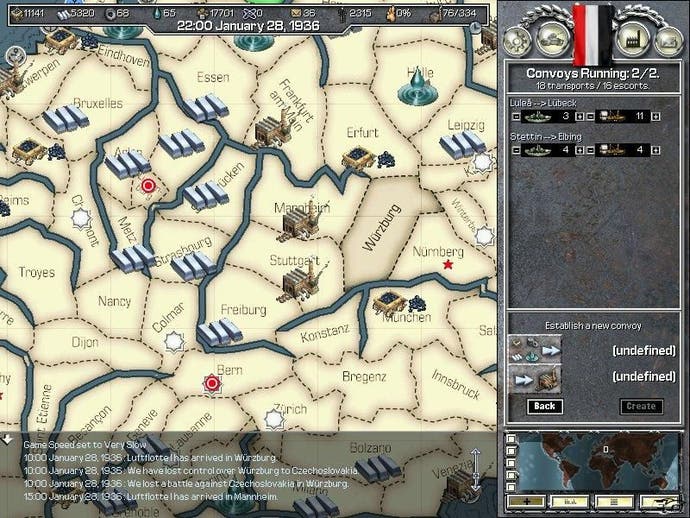Hearts of Iron
Review - Keith goes to war early
Ever wondered what would have happened had Hitler's Germany successfully defeated the British? What it would have been like had the United States decided to do something? Or whether the Italians could successfully invade Germany? Well, probably not the latter, but these and many more peculiar possibilities can be realised in World War II themed Hearts of Iron from Paradox, the makers of the successful Europa Universalis I & II strategy games.
Let's get it straight from the start though: Hearts of Iron is definitely old school. So if you are expecting snazzy graphics and gut wrenching audio, please collect your coat and have your ticket refunded at the door. Also, be warned, this really is for the die-hard strategist out there, not a simple drop in and have a quick play type of game. Those still with me, don your gas masks and buckle your seatbelts, it's time to go to war!

We Shall Defend Our Island
Your first port of call really ought to be the tutorials, as there is a heck of a lot of statistical information and a number of different game screens for you to negotiate cold. However, the tutorials are unforgivably poor, consisting of unfriendly reams of badly formatted text and yellow arrows that are often obscured, apparently showing you what you are currently learning. We quite literally gave up in the end, preferring to risk learning the game by myself instead of trying to make sense of the tutorials. In this day and gaming age a voice-driven tutorial system is not exactly hard to achieve, and would have made initial opinions far more favourable.
You have a choice of three periods of World War II to be dropped into, with accurate conditions for each, and having selected one, you get to choose which country you want to control. The warring nations are split into three distinct factions; the Allies, Axis and the Comintern, and your chosen country will be pigeonholed into whichever is appropriate, or can begin as a neutral. It is then a simple case of battling against the other factions for land occupancy, and whoever has the most points at the end of the scenario period wins. You can choose to play the game as pretty much any country imaginable, though naturally if you select a 'weaker' country (such as Portugal) you are going to find your influence on proceedings a touch more difficult than if you were to go full on as the Germans or the British.
Not helping matters, the interface really is quite cumbersome to use, and nothing seems to have been designed to make things easy for you. The first hour or so is spent simply trying to get your head round the interface. Unit location can be pretty confusing, and specific selection can be a frustrating affair. This is mainly because each province has them all piled on top of each other, and selecting individually involves clicking a tiny rectangular bar below the top unit. You would think that drag selecting would assist you with this, but it merely highlights the topmost unit, and nothing underneath! All the while you are valiantly trying to select a unit, message boxes pop up on the screen, providing you with useful information about so-and-so invading your territory, attacking your naval fleet etc, etc. These boxes just keep on coming though, and when you have to click 'OK' on each and every one of them it starts to make the blood boil. You can reduce the amount of pop-up messages via the horribly thought-out message options screen, but not being able to select all options means you have to go through every single option to disable the associated pop-up. Cheers for that.

Attack attack!
When you finally do start warring against another country you will happily sit back and watch your brave soldiers doing battle. Actually no, you will sit there, watching your unit move to the location via a thin status line, after instructing them with an attack plan, watch an uninspired animation of the battle scene and wait for a pop-up box telling you how you did. Not exactly riveting stuff. We're not asking for a full-on FPS-style graphical depiction here, just a little more in the way of separate news flashes coming from the scene along with a bit of audio to spice it up a little. Maybe even have the ability to issue new orders mid-fight, or alter unit aggression… anything! When you consider that the combat is one of the main aspects of the game, that lack of real involvement is a bit surprising. The combat box does give you scope for tactics though with the ability to set certain times for your units to attack, useful if you want to co-ordinate a ground force attack with airborne so they invade in unison.
HoI is played in real-time, though it follows a turn-based round system whereby all new game data is updated at noon every day. When you actually study what is going on in the game though, you realise just how impressive the game's data engine is. Every one of your units has a whole load of statistics attached to it, and combat will take all of these factors into consideration. Not only this, but you can govern what diplomatic relations you have with other countries, the supplies your provinces require and a whole plethora of other factors which can have a bearing on the final outcome of the game. Hell, you can even get stuck into the world trade market if you wish. This obscene amount of information is simply not going to be to everybody's tastes, but for an intricate tactician it is paradise.
As mentioned above, graphically the game will win no prizes, limited to a zoomable world map and still shots of various World War II locations. We also experienced a rather irritating flash of the screen every few seconds - whether this is an issue with our GeForce 4 Ti4200, we don't know, but it hurt. Furthermore, the small amount of animation that exists really is pretty poor, but it does serve the purpose of showing troop movement where a change of colour might just as well have done the job. Sound is also minimal, consisting of trudging shoes and engine sounds giving you notice of the unit you have selected. Hardly WarCraft, then. Elsewhere, music is rumbling classical fare, and generally grates after a very short period of time, so for us the music volume slider hit zero before long.
White Flag
The casual gamer should steer well clear. It just isn't very friendly and not the type of game you can drop into for a quick burn. However, for the more detail-driven strategy fan there is a lot to be commended, and a lot of pleasure to be extracted. You will often find the game AI to be inconsistent, in addition to the rather dull combat representation, but HoI offers LAN and internet options for up to eight hardcore strategy buffs, should you want that human touch. Internet play is actually good fun, if a little slow in getting a game going.
On the whole, my recommendation would be to try before you buy. Hearts of Iron is a tough nut to crack, but statistically minded war buffs would do well to investigate.
Hearts of Iron screenshots (PC)







